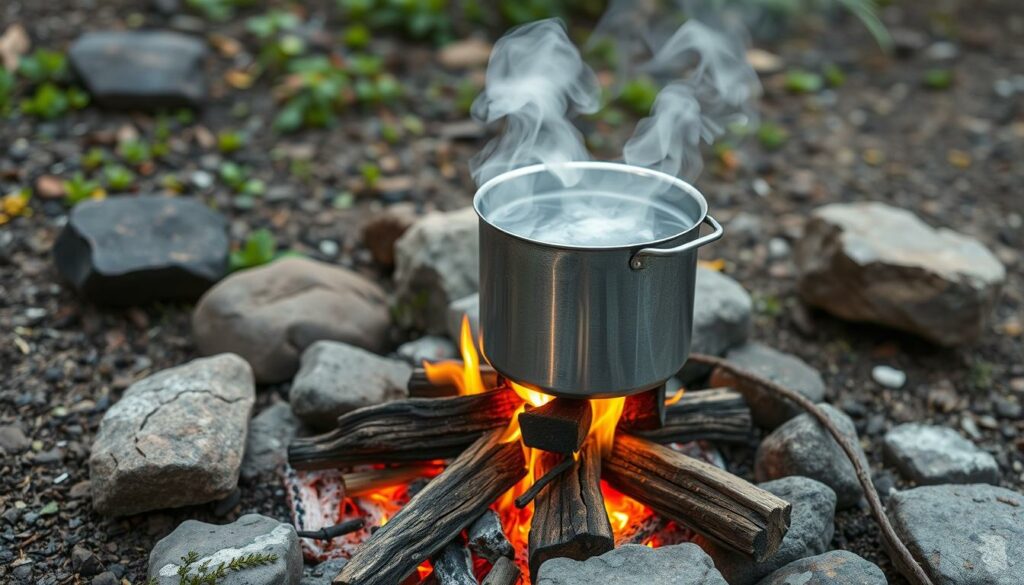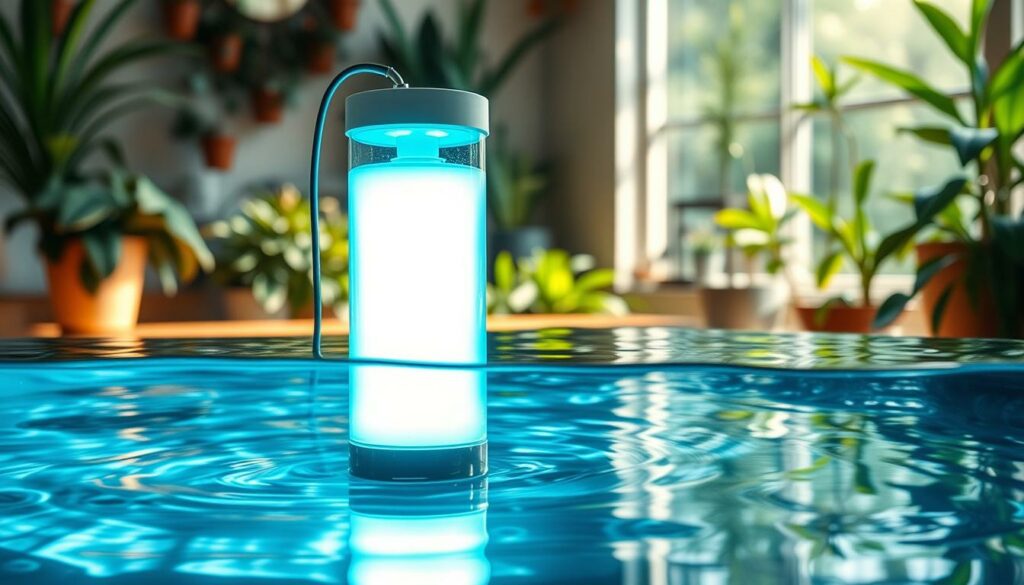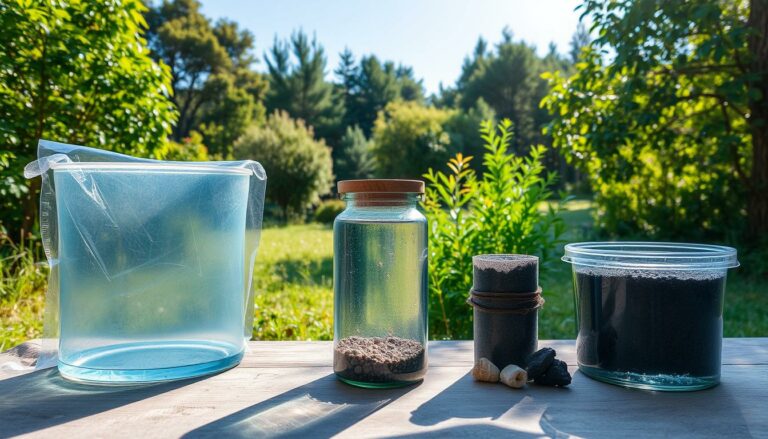Clean drinking water is essential but not always easy to get. Luckily, you can purify water yourself using simple methods. Boiling and making your own water filters are great ways to get safe water.
These methods are perfect for camping, during emergencies, or to improve your home’s water. They’re cheaper than buying expensive filters and let you control your water’s safety.
This guide will show you how to use the sun to clean water and make your own filters. You’ll see how to get rid of harmful stuff, make water taste better, and make sure it’s safe to drink and use.
Key Takeaways
- Boiling is the simplest method to kill most water-borne microorganisms
- Solar disinfection (SODIS) uses sunlight to purify water in PET bottles
- DIY charcoal filters can effectively remove impurities from water
- Homemade ceramic filters are great for removing bacteria and sediment
- Regular maintenance of DIY filtration systems is crucial for optimal performance
- UV light and reverse osmosis are advanced purification techniques
- Understanding common water contaminants helps in choosing the right purification method
Understanding the Importance of Water Purification
Clean drinking water is key for our health and well-being. But, many people around the world don’t have access to safe water. Water purification is vital to make sure we have clean water for drinking and daily use.
Health risks of contaminated water
Drinking contaminated water can be dangerous. The World Health Organization says it causes 1.8 million deaths each year from diarrhea. Diseases like cholera, dysentery, and typhoid spread easily in places without good water treatment.
Common water contaminants
There are many kinds of contaminants in water. These include tiny living things, chemicals, and heavy metals like lead and arsenic. Even though the EPA checks some contaminants in tap water, many others are not.
| Contaminant Type | Examples | Potential Health Effects |
|---|---|---|
| Microorganisms | Bacteria, viruses, parasites | Gastrointestinal illness, infections |
| Chemicals | Pesticides, industrial waste | Cancer, organ damage |
| Heavy Metals | Lead, arsenic, mercury | Neurological issues, developmental problems |
Benefits of purifying your own water
Purifying water at home has many benefits. It helps protect you from harmful contaminants, makes the water taste better, and is better for the planet than bottled water. By controlling your water’s quality, you make sure it’s safe and healthy for you and your family.
“Access to clean water is a fundamental human right. By understanding and implementing water purification techniques, we can safeguard our health and contribute to a more sustainable future.”
Boiling: The Simplest Purification Method
Boiling is one of the oldest and most effective ways to purify water. It kills most harmful bacteria and parasites, making it a top choice for clean drinking water. Just bring the water to a rolling boil for one minute at sea level or three minutes higher up.

Boiling gets rid of most pathogens but doesn’t touch chemical contaminants or improve taste. It’s great during boil water advisories or emergencies when other methods aren’t available.
“Boiling water for 10-15 minutes is considered effective for purification.”
Let’s look at how boiling compares to other ways to purify water:
| Method | Effectiveness | Cost | Ease of Use |
|---|---|---|---|
| Boiling | High for pathogens | Low | Very Easy |
| Chlorination | High for bacteria | Low | Easy |
| UV Purification | High for most contaminants | Medium | Moderate |
| Carbon Filtration | High for impurities | Medium | Easy |
Boiling is a cheap and easy way to purify water, but it’s good to look at other options too. Checking out different methods can help make sure you have clean drinking water in all kinds of situations.
Solar Water Disinfection (SODIS)
Solar Water Disinfection (SODIS) is a simple way to clean water at home using the sun. It’s widely used in developing countries and endorsed by the World Health Organization for home water treatment.
How SODIS Works
SODIS uses UV light and heat from the sun to kill harmful germs in water. This method works best in areas between 15° and 35° latitude. These places get a lot of sun and have little cloud cover.
Materials Needed for SODIS
To make your own SODIS, you’ll need:
- Clear PET plastic bottles
- Untreated water
- Sunny area
Step-by-Step SODIS Process
- Fill a clear PET bottle with water
- Put the bottle in direct sunlight
- Leave it for 6 hours on a sunny day or 2 days if it’s cloudy
- Drink the clean water
SODIS is a low-cost way to make drinking water safer. It can cut down on diarrhea in kids by 16-88%. For the best results, use bottles that are in good shape and put them on reflective surfaces.
| Condition | Exposure Time |
|---|---|
| Bright to 50% cloudy | 6 hours |
| 100% cloudy | 2 days |
| Continuous rainfall | Not recommended |
While SODIS kills germs well, it doesn’t remove chemicals or make water clear. It’s a simple yet effective way to purify water at home in many situations.
Homemade Charcoal Filters
Making your own water filters with charcoal is a great DIY project. It uses activated carbon to clean water, which is great for outdoor lovers and those wanting to be self-sufficient.
To make a charcoal filter, you need a large chocolate tin, wood offcuts (like oak), and a 4-inch funnel with a coffee filter. First, create activated carbon, which has a special surface that regular charcoal doesn’t.
Activate the charcoal by burning wood chunks in a can with holes until the smoke stops. Then, soak the charcoal in cold water. This makes a filter material that’s similar to store-bought activated carbon but cheaper.
“Homemade charcoal filters are primarily effective for low-level chemical removal, making them a great addition to your water purification toolkit.”
Build your filter by layering fine sand, gravel, and crushed charcoal in a container. This setup catches big particles and some contaminants. But remember, these filters don’t remove all harmful germs or viruses.
| Filter Component | Function |
|---|---|
| Activated Charcoal | Absorbs chemicals and improves taste |
| Fine Sand | Traps small particles |
| Gravel | Supports filter layers and improves water flow |
For the best results, use this method with other ways to purify water. It takes about two weeks for a sand biofilter to get rid of most diseases. This is because it builds a good layer of beneficial sludge over time.
Water purification DIY: Creating a Multi-Layer Filter
Making your own water filters at home is a great way to purify water. A multi-layer filter is a good choice for clean drinking water. We’ll look at what you need and how to build your own filter.
Materials needed for a multi-layer filter
You’ll need these items for a DIY water purification system:
- Two 2-gallon food-grade plastic pails with lids
- Fine cotton cloth
- Traditional pyrolysis-produced charcoal
- Sand (preferably sea sand)
- Small pebbles or gravel
- Antimicrobial plants (e.g., Thyme, Pine Needles, Juniper)
Step-by-step construction guide
Here’s how to build your multi-layer filter:
- Clean the pails well
- Drill small holes in the bottom of one pail
- Layer the materials in this order: cloth, charcoal, sand, pebbles, plants
- Make sure layers are packed tightly to avoid gaps
- Put the filtered pail on top of the second pail
Maintenance and replacement of filter materials
To keep your filter working right:
- Replace the cotton layer after many uses
- Clean the pebbles and sand now and then
- Change the charcoal layer every few months
- Update the plant layer as needed
| Layer | Function | Maintenance |
|---|---|---|
| Cloth | Strains particulate matter | Replace after multiple uses |
| Charcoal | Absorbs impurities | Change every few months |
| Sand | Traps suspended particles | Clean periodically |
| Pebbles | Removes larger debris | Clean periodically |
| Plants | Inhibits microbial growth | Refresh as needed |
UV Light Purification Techniques
UV light purification is a top choice for making water safe. It uses ultraviolet light to kill harmful germs. This makes sure the water is clean to drink.

UV systems kill 99.99% of viruses and 99.9999% of bacteria. They use a special light with a wavelength of 254 nanometers. This light has enough power to kill germs in drinking water.
This method is great because it doesn’t change the water’s taste or quality. It works well against tough germs like Cryptosporidium and Giardia. These germs are hard to kill with chemicals.
| Aspect | UV Purification | Ozone Generator |
|---|---|---|
| Efficiency | 99.99% microbe elimination | High, requires aeration |
| Taste Impact | No change | May affect taste |
| Upfront Cost | Higher | Lower |
| Maintenance | Annual lamp replacement | Regular cleaning |
UV purification is great at killing germs but doesn’t remove chemicals or improve taste. For best results, make sure the water is clear. Also, follow the flow rate suggested by the maker.
Chemical Purification Methods
Chemical methods are a simple and effective way to purify water at home. They are great for outdoor lovers and those wanting to clean water at home. Let’s look at some common chemical methods to make sure your water is safe.
Chlorine Tablets and Drops
Chlorine is a strong disinfectant that kills harmful bacteria and viruses. You can find chlorine tablets or drops easily. For the best results, use them in water that’s at least 21°C (70°F).
After adding the recommended amount, wait about 20 minutes before drinking. This method works well for up to 20 liters of water. It’s perfect for larger amounts.
Iodine-Based Purifiers
Iodine is another great chemical for purifying water. It comes in tablet or liquid form. Iodine is effective against pathogens but might change the taste of the water slightly.
If you’re sensitive to iodine or pregnant, choose another method. Like chlorine, you’ll need to wait 20 minutes before the water is safe to drink.
Potassium Permanganate Treatment
Potassium permanganate is not as common but can purify water at home. It kills bacteria and improves taste and odor. But, be careful with the dosage as too much is harmful.
This method is especially useful in tropical areas where water might have more contaminants.
| Method | Effectiveness | Taste Impact | Wait Time |
|---|---|---|---|
| Chlorine | High | Minimal | 20 minutes |
| Iodine | High | Noticeable | 20 minutes |
| Potassium Permanganate | Moderate | Improves | Varies |
While these chemical methods work well against many pathogens, they might not remove all contaminants. For the best purification, consider using chemical treatment with other methods like filtration or boiling.
Natural Purification Using Plants and Fruits
Nature has surprising ways to purify water. Studies show that common fruits and vegetables can help make homemade water filters. For example, lemon peels and seeds are great at removing lead ions from water.
Lemon peels got rid of 96% of lead ions. The seeds removed a full 100%. Okra, a vegetable not often thought of for this, also works well. Its peels took out all lead ions, and the seeds cut the amount in half.
Using plants and fruits to purify water is easy. It uses adsorption, where pollutants stick to the peel surfaces. This method can be done at home in just four steps. It’s a good option for those looking for alternative ways to purify water.
But remember, these natural methods should be used with other purification ways to make sure the water is safe. Boiling water for 10 minutes is still a top way to purify water in the wild. If you want more options, try a DIY filter with activated charcoal, sand, and gravel in a plastic bottle for extra cleaning.
Source Links
- https://www.rusco.com/blog/diy-water-filtration-cost-effective-methods-for-purifying-your-water
- https://www.h2odistributors.com/info/how-to-make-a-water-filter/?srsltid=AfmBOoovk7eFu4Ymt7X_84DviwZvjOt52A9DrR_dvmfu5Lb3ScAm_uBe
- https://atlas-scientific.com/blog/water-purification-methods/
- https://carewater.solutions/en/water-purification-is-important-to-human-health/
- https://www.onlymyhealth.com/water-purification-at-home-1574424549
- https://www.filtsep.com/content/blog/effective-and-proven-ways-to-purify-your-water-at-home/
- https://en.wikipedia.org/wiki/Solar_water_disinfection
- https://www.ncbi.nlm.nih.gov/pmc/articles/PMC8201346/
- https://sswm.info/sswm-solutions-bop-markets/affordable-wash-services-and-products/affordable-water-supply/sodis
- https://www.generationgenius.com/activities/water-quality-and-distribution-activity-for-kids/
- https://permies.com/t/210339/Build-Charcoal-Water-Filter
- https://homedistiller.org/forum/viewtopic.php?t=12697
- https://cityprepping.com/blog/skill/diy-two-bucket-wilderness-water-filtration-system-with-enhanced-microbial-removal/
- https://www.instructables.com/Easy-Water-Filtration/
- https://diysolarforum.com/threads/solar-powered-uv-water-filter.45674/
- https://espwaterproducts.com/pages/understanding-uv-water-filtration-sterilization?srsltid=AfmBOoql-G7Pqe6N1Jc6P7Tli3ZF_UyGwCjIItlKQPwsok0IB7-SC4wN
- https://www.schultzsoftwater.com/blog/4-methods-to-purify-your-water
- https://unchartedsupplyco.com/blogs/news/purify-water-in-wild?srsltid=AfmBOorR9kx7S05A3r70oH-qZ5AQxT966Tuj0fTem_APJ3qQySrWhY_b
- https://www.firstforwomen.com/health/how-to-use-fruit-vegetable-peels-to-purify-water-164172
- https://unchartedsupplyco.com/blogs/news/purify-water-in-wild?srsltid=AfmBOooriTzIeLn79Jv7L5l_LwheiO61RWyRF1IBCOHa-KA2q-YIiYwT
- https://www.wikihow.com/Make-a-Water-Filter

